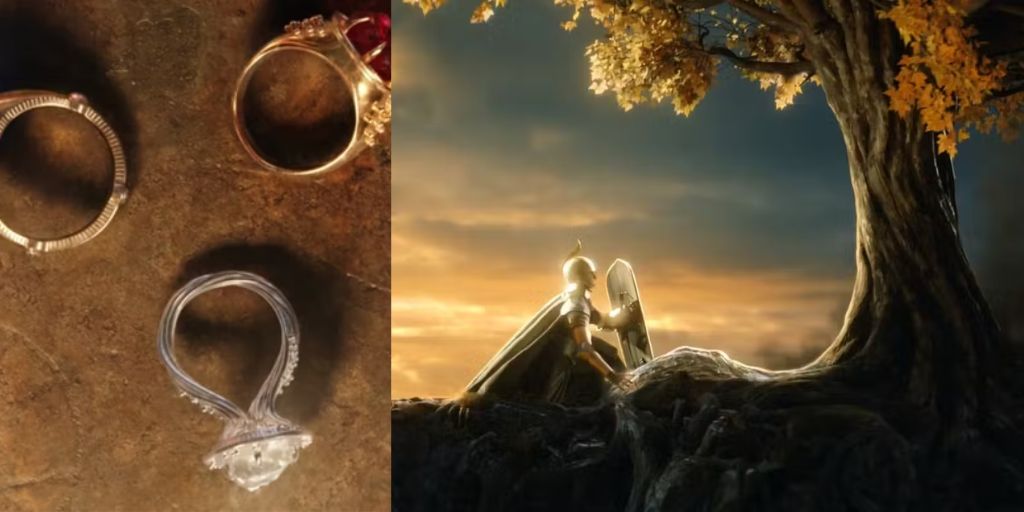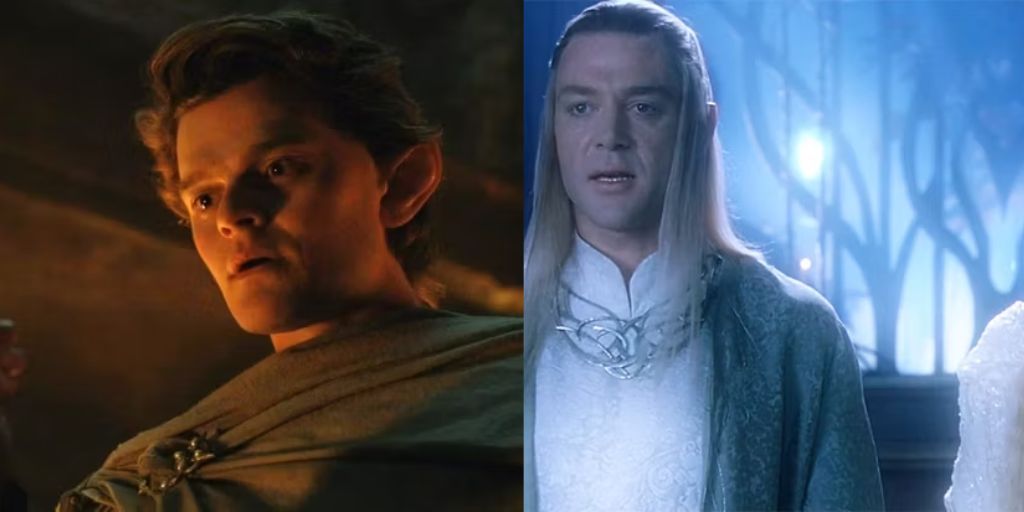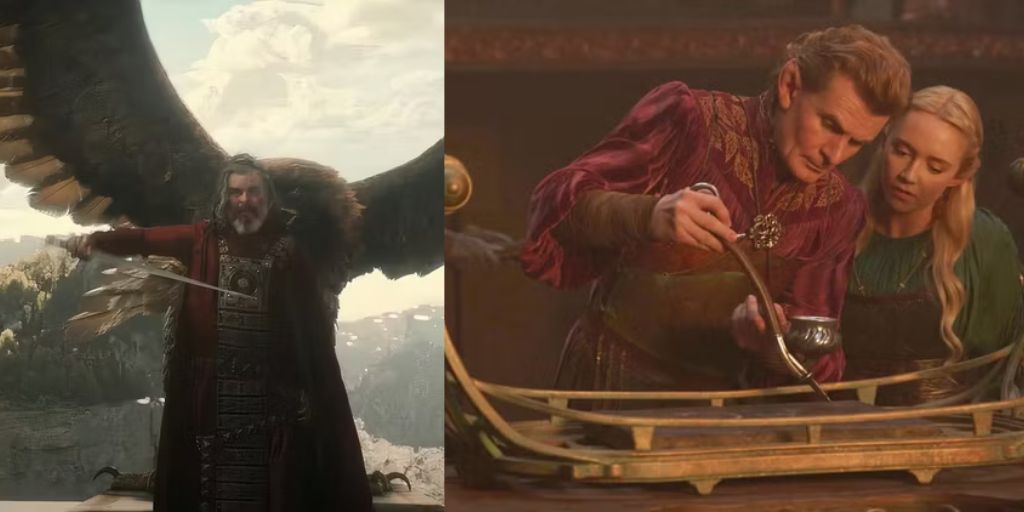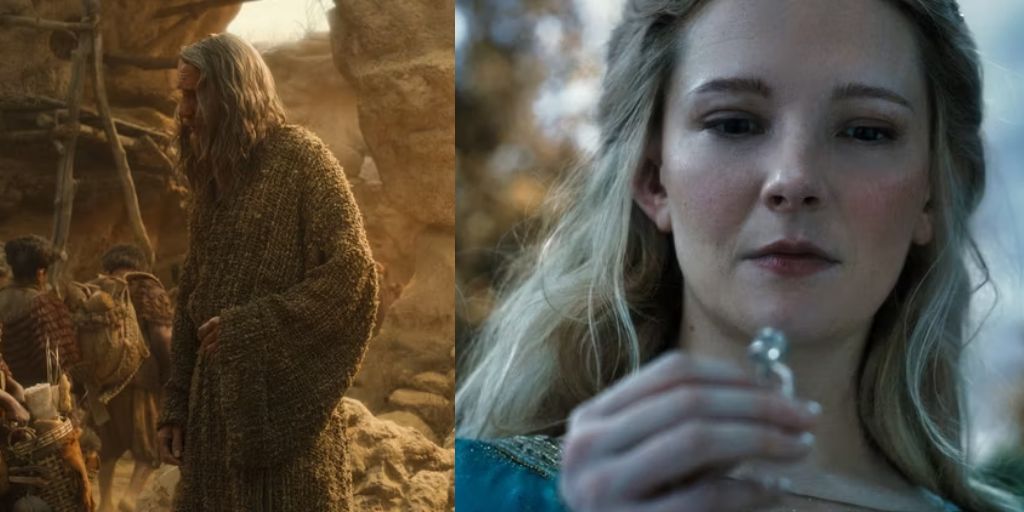The Rings of Power has shown both greatness and confusion, from the powerful and terrifying Sack of Eregion to the perplexing mithril subplot.
This mithril storyline, paired with the Elves’ rush to save their race, left many viewers scratching their heads. With two seasons now available, it’s time to look at the show’s direction and its relationship with Tolkien’s original work.
While the story has become clearer, it still leaves viewers with many questions. There’s enough content to start comparing how the show stacks up against J.R.R. Tolkien’s books. So, how does it measure up? Does it honor the source material?
One unfortunate reality of successful adaptations is that they can sometimes mix up the original story in the minds of viewers. Audiences may find it hard to remember which parts come from the original books and which are cinematic inventions.
As an example, many fans of The Lord of the Rings mistakenly believe Sauron was just a giant flaming eye. This confusion underscores the importance of keeping Tolkien’s work and the show’s creative decisions clear. Here, we’ll break down the most significant differences between The Rings of Power and Tolkien’s writings.
At the beginning of the story, we learn that Galadriel (played by Morfydd Clark) is driven by a combination of motivations.
Her brother, Finrod (Will Fletcher), made a vow to hunt down and destroy Sauron, but Sauron got to him first and killed him. This gives Galadriel two reasons to pursue Sauron: revenge for her brother and a desire to fulfill Finrod’s uncompleted vow.
While parts of this backstory fit Tolkien’s narrative, much of it is an invention of the show. In the books, Finrod never swore an oath to find Sauron, and Sauron wasn’t hiding when Finrod encountered him. In reality, Sauron was ruling from an evil fortress he had stolen from the Elves, openly declaring his power.
Finrod met Sauron while helping Beren steal a Silmaril from Morgoth’s crown, and technically, Finrod wasn’t killed directly by Sauron. He died in Sauron’s dungeons after fighting a werewolf with his bare hands. While it makes sense for the show to tie Galadriel’s anger to Sauron, this is a major departure from Tolkien’s books.

There are also several significant differences between the Gil-galad of Tolkien’s books and the Gil-galad played by Benjamin Walker in the show.
In the first episode, Gil-galad seems to have the authority to send Elves to Valinor and manage their passage. Elrond (Robert Aramayo) even adds that “no one has ever refused the summons” to Valinor, which increases the seriousness of the situation.
However, this is largely inaccurate. Even the High King of the Noldor didn’t have the power to grant Elves passage to Valinor. Only the Valar could extend that invitation, and it wasn’t a “get out of jail free” card that an Elvish king could use at will.
Moreover, many Elves had refused the summons by the time Galadriel was asked. In fact, when the Valar first invited the Elves to Valinor, some refused outright, and others changed their minds halfway.
By the Second Age, many Elves had turned down this call to Valinor, including Galadriel, who had even refused a pardon from the Valar.
In the show, Gil-galad is also depicted as having authority over the Silvan Elves in Tirharad. Arondir (Ismael Cruz Cordova) follows orders from Gil-galad in the beginning of the series, though in Tolkien’s world, this wouldn’t have been possible.
Gil-galad was the High King of the Noldor, and the Silvan Elves were not part of his domain. Therefore, Gil-galad had no authority over them.
Perhaps the most surprising difference between the Gil-galad of the books and the show is his character. In Tolkien’s writings, Gil-galad was a fair and just king, committed to preserving the memory of Valinor in Middle-earth. He was a wise ruler who resisted Sauron’s tricks, while Celebrimbor was fooled by them.
However, in Season 1 of The Rings of Power, Gil-galad appears manipulative and distant. He treats Elrond coldly and seems to fully support Celebrimbor’s plans, whereas in the books, Gil-galad was much more cautious.
In the series, he is the first to lose hope and give up on the Elves’ future, a sharp contrast to his hopeful nature in the books. Although Gil-galad may experience character growth in future seasons, he is far from the noble figure described by Tolkien.
The Palantíri, or seeing-stones, also work differently in the show compared to Tolkien’s descriptions. In the books, the Palantíri could see great distances in both time and space, and some could even communicate with one another.
However, Tolkien specified that they could only look into the past, not the future. In The Rings of Power, however, Galadriel and Miriel (Cynthia Addai-Robinson) use the Palantír to see a future disaster coming for Númenor.
This shift from Tolkien’s original design significantly changes the role of the Palantíri in the story, as the stones become tools for predicting and preventing events, rather than simply observing the past.

Elendil (played by Lloyd Owen) is introduced with a vague mention of his noble ancestry. In the books, Elendil’s backstory is much more detailed. Pharazôn (Trystan Gravelle) should know exactly who Elendil is, since Pharazôn was once friends with Elendil’s father, and Elendil’s family were important advisors to the Númenórean kings for a long time.
Even after Númenor’s destruction, Elendil’s family remained influential in Middle-earth. The show’s decision to downplay these connections is odd, though it does hint at Elendil’s future rise in power as he aligns with the Faithful and plays a central role in the power struggles of Númenor.
The show’s timeline is also significantly different from Tolkien’s original timeline. The rise and fall of Númenor is condensed from thousands of years into a much shorter period. Events like the forging of the Rings of Power and the fate of Khazad-dûm are also moved around to fit the show’s narrative.
This reshuffling helps keep immortal and mortal characters in sync, but it also causes confusion. For instance, Númenor’s unrest escalates far too quickly, and the Balrog storyline becomes rushed, with mithril not yet gaining importance before the creature is released.
However, it’s understandable why the timeline was condensed—adapting Tolkien’s vast history would be impossible to fit into a television series.
One unresolved mystery in The Rings of Power is the fate of Galadriel’s husband, Celeborn. In Season 1, Galadriel says that he is dead, but in Tolkien’s works, Celeborn was never missing or presumed dead.
The couple was separated for a time, but that was because Galadriel crossed through Khazad-dûm, and Celeborn refused to follow. The fact that one of the main character’s husbands is missing, with no explanation as to what he is doing, is a major change from Tolkien’s writings.
The first season’s finale suggested that the story about mithril and its magical healing properties was true. However, this interpretation of mithril is far removed from Tolkien’s work. In the books, mithril is rare and mostly found in Khazad-dûm, but it doesn’t have anything to do with a Silmaril tree or magical healing.
The idea of mithril being tied to the Light of Valinor, and the Elves’ fading, is also a big departure. Tolkien did write about the Elves fading, but it wasn’t tied to the light or happening as quickly as the show suggests.
Another deviation from the source material concerns Elrond and his knowledge of the Silmarils. In the books, Elrond knew the fate of the Silmarils since he had seen one of them himself.
One of the Silmarils is on his father’s brow in the night sky, and the other two were taken by Maedhros and Maglor. Therefore, it’s odd that the show would suggest Elrond believed the legend about mithril being connected to a Silmaril.
The creation of the Elven Rings is another area where the show diverges from Tolkien’s story. While Halbrand (Charlie Vickers) is revealed to be Sauron at the end of Season 1, his involvement in forging the Rings is much more incidental than it was in the books.
In Tolkien’s version, Sauron, disguised as Annatar, played a central role in inspiring the idea of the Rings and guiding Celebrimbor in their creation. In the show, Sauron arrives late in the process and has less direct influence.
The show also adds material that fills in gaps left by Tolkien. For example, the friendship between Elrond (Robert Aramayo) and Durin (Owain Arthur) is one of the highlights of the series, though Tolkien never mentioned it in Elrond’s backstory.

The show also introduces a conflict between Durin III and Durin IV, an invention for the series. In Tolkien’s writings, the Dwarves believed that the two Durins were reincarnations of one another, so they wouldn’t have been alive at the same time.
Although Tolkien never specified when Khazad-dûm fell to the Balrog, the idea that mithril was linked to the Dwarven kingdom’s destruction is an original creation for the show.
There’s also no mention in the books of the character Theo (Tyroe Muhafidin), the Harfoots, or the Stranger (Daniel Weyman), who may or may not be Gandalf.
These characters seem to be designed to connect the main narrative of the Rings of Power with other parts of Middle-earth’s history. Their inclusion has sparked debate among fans about whether these original characters add to the story or distract from the more traditional elements of Tolkien’s world.
Despite these deviations from Tolkien’s work, The Rings of Power presents an expansive and immersive take on Middle-earth. However, for fans looking for a faithful adaptation of the lore, these creative liberties may feel like significant departures from the source material.
Balancing the richness of Tolkien’s writings with the demands of modern television is a challenge, and only time will tell if the series will stay true to the spirit of the books or continue to forge its own path.
While The Rings of Power borrows from Tolkien’s vast mythology, it also reinterprets key elements for modern storytelling. These changes have sparked mixed reactions from fans, with some appreciating the fresh take, while others prefer a closer adherence to the original texts.
The show’s alterations, like Galadriel’s quest, the magical properties of mithril, and the introduction of new characters, offer a more dramatic and visually exciting experience, but they sometimes stray from the rich details that Tolkien crafted over decades.
Despite these differences, The Rings of Power captures the grandeur and complexity of Middle-earth, introducing it to a new generation of viewers.
As the series progresses, it will be interesting to see how it continues to balance the source material with its own creative vision.
While some deviations are controversial, the series maintains Tolkien’s themes of heroism, sacrifice, and the ongoing battle between good and evil. In the end, both versions provide unique windows into one of the most beloved fantasy worlds ever created.




